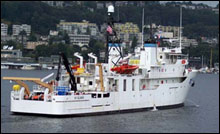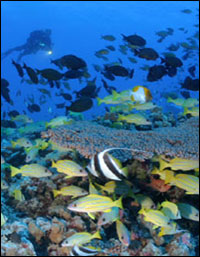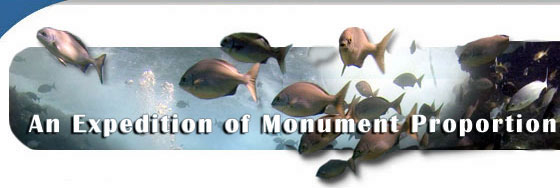|
Bringing the Place to the People: Expanding Understanding and Awareness of the Northwestern Hawaiian Islands
Claire Johnson, National Education Liaison
NOAA National Marine Sanctuaries
Andy Collins, Education Coordinator
Northwestern Hawaiian Islands Marine National Monument
Experiential education is the cornerstone for change, and exposure of a select group of educators to the unique environments of the Northwestern Hawaiian Islands will aid in bringing the place to the people. Since it would be too great an impact to bring a large number of educators to this amazing ocean wilderness for a first hand experience, we will transfer this experience to others creating a ripple effect through the broader Hawai’i community. This may also inspire teachers from all over the country to learn about the Northwestern Hawaiian Islands and teach about them in their classrooms. People need to understand a place in order to care about it and want to conserve it for future generations.
The five members that make up the education and outreach team aboard the NOAA ship Hi’ialakai during the June 23-July 20, 2006 cruise are tasked with interpreting the research for a broad audience, using several established mechanisms, such as this online expedition log and scientist interviews through podcasting. In order to bring this special place to teachers and their students, the team will also develop standards-based lesson plans, activities and educational interactive maps that will help increase the understanding of marine science, Native Hawaiian culture, conservation management and marine policy, as well as the ecosystems of the Hawaiian archipelago.
 | | The NOAA ship HI'IALAKAI will be supporting a multidisciplinary research expedition which includes a benthic habitat mapping team, maritime archaeologists and interpretation of this research through education and outreach specialists. (Photo: NOAA) |
On any given day the education and outreach team will be joining the maritime heritage archaeologists on small launch boats from the ship. Donning our snorkel gear to observe and gain first-hand experience of the work necessary to document and conserve shipwrecks such as the Pearl and Hermes whaling vessels sunk off the atoll of the same name. The education team will also stay aboard the NOAA ship Hi’ialakai to interact with the mapping experts to interpret their research and develop activities related to this important work. The mapping being conducted onboard the vessel will aid in management of the area, and will lay down a baseline upon which other studies will be conducted.
REEF aims to educate and enlist divers in the conservation of marine habitats primarily through its fish survey project. This project allows volunteer snorkelers and scuba divers to collect and report data on species abundance and diversity of marine fish populations. The main Hawaiian Islands have been included in this international project, yet REEF fish surveys are more rare in the Northwestern Hawaiian Islands, so contributing to this data collection is an important goal of the education and outreach team.
 | | The abundance of fish in a healthy coral reef ecosystem are part of what makes the Nortwhestern Hawaiian Islands so special. (Photo: James Watt) |
Another project the education and outreach team will be supporting during this research cruise will be the deployment and retrieval of the AULS. The Sanctuary Sounds project has made these underwater listening stations available to all 14 marine protected areas managed by the NOAA National Marine Sanctuary Program to compile a complete record of natural and man-made underwater sounds. This library of recordings can then be used for educational products; piped into science centers to immerse the visitor into the marine environment; and serve as research data sets. It is possible that the audio data collected can also be used as a management tool in support of the Northwestern Hawaiian Islands Marine National Monument, State Marine Refuge and the Hawaiian Islands National Wildlife Refuge.
All of these education and outreach activities aim to motivate people to change their attitudes and behaviors to better care for coral reefs and related marine environments, as well as to be better stewards for the ocean. Through the virtual experience, and learning about the near-pristine marine environment of the Northwestern Hawaiian Islands it is intended that teachers and students alike will become aware of how the marine environments near human populations have been impacted, and inspire them to think of ways to restore these areas. The Northwestern Hawaiian Islands Marine National Monument is the largest conservation area in the United States, larger than all the lands managed by the National Park Service. Within its borders are vast and healthy coral reefs, endangered and threatened species, and important Hawaiian cultural sites. This is your chance to learn more and make a difference by your every day actions.
|



